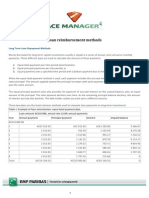Mortgage Calculator
Mortgage Calculator
Uploaded by
api-246390576Copyright:
Available Formats
Mortgage Calculator
Mortgage Calculator
Uploaded by
api-246390576Original Title
Copyright
Available Formats
Share this document
Did you find this document useful?
Is this content inappropriate?
Copyright:
Available Formats
Mortgage Calculator
Mortgage Calculator
Uploaded by
api-246390576Copyright:
Available Formats
Mortgage calculators are used to help a current or potential real estate owner determine how much they can
afford to borrow on a piece of real estate. Mortgage calculators can also be used to compare the costs, interest rates, payment schedules, or help determine the change in the length of the mortgage loan by making added principal payments. A mortgage calculator is an automated tool that enables the user to quickly determine the financial implications of changes in one or more variables in a mortgage financing arrangement. The major variables include loan principal balance, periodic compound interest rate, number of payments per year, total number of payments and the regular payment amount. Mortgage calculation capabilities can be found on financial handheld calculators such as TI BA II Plus. There are also multiple free online free mortgage calculators, and software programs offering financial and mortgage calculations. Contents Uses When purchasing a new home, most buyers choose to finance a portion of the purchase price via the use of a mortgage. Prior to the wide availability of mortgage calculators, those wishing to understand the financial implications of changes to the five main variables in a mortgage transaction were forced to use rate tables. These tables generally required a working understanding of compound interest mathematics for proper use. In contrast, mortgage calculators make answers to questions regarding the impact of changes in mortgage variables available to everyone. Mortgage calculators can be used to answer such questions as: If one borrows $250,000 at a 7% annual interest rate and pays the loan back over thirty years, with $3,000 annual property tax payment, $1,500 annual property insurance cost and 0.5% annual private mortgage insurance payment, what will the monthly payment be? The answer is $2,142.42. A potential borrower can use an online mortgage calculator to see how much property he or she can afford. A lender will compare the person's total monthly income and total monthly debt load. A mortgage calculator can help to add up all income sources and compare this to all monthly debt payments. It can also factor in a potential mortgage payment and other associated housing costs (homeownership dues, etc.). One can test different loan sizes and interest rates. Generally speaking, lenders do not like to see all of a borrower's debt payments (including property expenses) exceed around 40% of total monthly pretax income. Some mortgage lenders are known to allow as high as 55%. Monthly payment formula The fixed monthly payment for a fixed rate mortgage is the amount paid by the borrower every month that ensures that the loan is paid off in full with interest at the end of its term. The monthly payment formula is based on the annuity formula . The monthly payment c depends upon:
r - the monthly interest rate , expressed as a decimal, not a percentage. Since the quoted yearly percentage rate is not a compounded rate, the monthly percentage rate is simply the yearly percentage rate divided by 12; dividing the monthly percentage rate by 100 gives r, the monthly rate expressed as a decimal. N - the number of monthly payments, called the loan's term, and P - the amount borrowed, known as the loan's principal.
In the standardized calculations used in the United States, c is given by
the For example, for a home loan for $200,000 with a fixed yearly interest rate of 6.5% for 30 years, the principal is , the monthly interest rate is , the number of monthly payments is , the fixed monthly payment equals $1,264.14. This formula is provided using the financial function PMT in a such as . In the example, the monthly payment is obtained by entering either of the these formulas: = PMT(6.5 / 100 / 12, 30 * 12, 200000) = ((6.5 / 100 / 12) * 200000) / (1 - ((1 + (6.5 / 100 / 12)) ^ (-30 * 12))) = 1264.14 The following derivation of this formula illustrates how fixed-rate mortgage loans work. The amount owed on the loan at the end of every month equals the amount owed from the previous month, plus the interest on this amount, minus the fixed amount paid every month. This fact results in the debt schedule: Amount owed at initiation: Amount owed after 1 month: Amount owed after 2 months: Amount owed after 3 months:
.................................................. Amount owed after N months:
payment c (with that
appearing before the fixed monthly ) is called; it has a simple obtained from observing because all but the first and last terms in this yields the much
difference cancel each other out. Therefore, solving for simpler
Applying this fact about to the amount owed at the end of the Nth month gives (using succinctly denote the function value Amount owed at end of month N at argument value x = (1+r )):
to
The amount of the monthly payment at the end of month N that is applied to principal paydown equals the amount c of payment minus the amount of interest currently paid on the pre-existing unpaid principal. The latter amount, the interest component of the current payment, is the interest rate r times the amount unpaid at the end of month N1. Since in the early years of the mortgage the unpaid principal is still large, so are the interest payments on it; so the portion of the monthly payment going toward paying down the principal is very small and equity in the property accumulates very slowly (in the absence of changes in the market value of the mortgage calculator property). But in the later years of the mortgage, when the principal has already been substantially paid down and not much monthly interest needs to be paid, most of the monthly payment goes toward repayment of the principal, and the remaining principal declines rapidly. The borrower's equity in the property equals the current market value of the property minus the amount owed according to the above formula. With a fixed rate mortgage, the borrower agrees to pay off the loan completely at the end of the loan's term, so the amount owed at month N must be zero. For this to happen, the monthly payment c can be obtained from the previous equation to obtain:
which is the formula originally provided. This derivation illustrates three key components of fixed-rate loans: (1) the fixed monthly payment depends upon the amount borrowed, the mortgage calculator interest rate, and the length of time over which the loan is repaid; (2) the amount owed every month equals the amount owed from the previous month plus interest on that amount, minus the fixed monthly payment; (3) the fixed monthly payment is chosen so that the loan is paid off in full with interest at the end of its term and no more money is owed.
You might also like
- Chapter 7 Case - Valuation Ratios in The Restaurant IndustryDocument2 pagesChapter 7 Case - Valuation Ratios in The Restaurant IndustrySarah Ihugo40% (5)
- Amortization Schedule - WikipediaDocument8 pagesAmortization Schedule - Wikipediapuput075100% (2)
- Loan AmortizationDocument3 pagesLoan AmortizationMarvin AlmariaNo ratings yet
- Example Amortization ScheduleDocument3 pagesExample Amortization SchedulePankil R ShahNo ratings yet
- C1 D1 Doc Tech 2Document4 pagesC1 D1 Doc Tech 2Suman TiwariNo ratings yet
- C1 D1 Doc Tech 2Document4 pagesC1 D1 Doc Tech 2Anggi Gayatri SetiawanNo ratings yet
- Loan AmortizationDocument14 pagesLoan AmortizationPoorvajaNo ratings yet
- Finance - Self Study Guide For Staff of Micro Finance InstitutionsDocument9 pagesFinance - Self Study Guide For Staff of Micro Finance InstitutionsmhussainNo ratings yet
- Mortgage CalculatorDocument4 pagesMortgage CalculatorSANDEEPNo ratings yet
- Periodic Payments: AmortizationDocument4 pagesPeriodic Payments: AmortizationRutvi Shah RathiNo ratings yet
- 4 PDFDocument7 pages4 PDFblitzkrigNo ratings yet
- Solutions To ProblemsDocument5 pagesSolutions To Problemsfiazzk1265No ratings yet
- Buyingahouse 1Document4 pagesBuyingahouse 1api-251852099100% (1)
- Real Estate Lecture-6 Feb-27Document11 pagesReal Estate Lecture-6 Feb-27Md Tanvir HasanNo ratings yet
- Term Loan Ion CalculatorDocument3 pagesTerm Loan Ion CalculatorPrachi SinghNo ratings yet
- Amortization Calculator - Wikipedia, The Free EncyclopediaDocument3 pagesAmortization Calculator - Wikipedia, The Free Encyclopediaapi-3712367No ratings yet
- Premium Discount Par: Understanding The Time Value of MoneyDocument5 pagesPremium Discount Par: Understanding The Time Value of Moneyvaibhavc87No ratings yet
- Understanding Interest Rate in Theory and Its Modification That Is Used in RealityDocument18 pagesUnderstanding Interest Rate in Theory and Its Modification That Is Used in RealityHanim FaizahNo ratings yet
- Premium Discount Par: Understanding The Time Value of MoneyDocument5 pagesPremium Discount Par: Understanding The Time Value of Moneyvaibhavc87No ratings yet
- 1050 WordDocument6 pages1050 Wordapi-352291519No ratings yet
- Annual Percentage RateDocument8 pagesAnnual Percentage Ratetimothy454No ratings yet
- Appraised Value Is The Financial Worth Placed On A Real Property Based On A Report by An Appraiser, Who Is ADocument4 pagesAppraised Value Is The Financial Worth Placed On A Real Property Based On A Report by An Appraiser, Who Is AMichelle GozonNo ratings yet
- Application of Engineering or Mathematical Analysis and Synthesis To Decision Making in EconomicsDocument6 pagesApplication of Engineering or Mathematical Analysis and Synthesis To Decision Making in EconomicsmizaelledNo ratings yet
- ABSNet GlossaryDocument37 pagesABSNet Glossaryapi-3778585No ratings yet
- Effective Interest RateDocument4 pagesEffective Interest RateJoseph WongNo ratings yet
- Advanced Bond ConceptsDocument32 pagesAdvanced Bond ConceptsJohn SmithNo ratings yet
- BusMath Q1 Mod8Document18 pagesBusMath Q1 Mod8Romeo CorporalNo ratings yet
- Abcs of Computing InterestDocument22 pagesAbcs of Computing InterestKasapaNo ratings yet
- Math 1 Chapter 2 Consumer MathDocument24 pagesMath 1 Chapter 2 Consumer MathJohn Christian Elmo TabaneraNo ratings yet
- Home Mortgage - College AlgebraDocument11 pagesHome Mortgage - College AlgebraDebalina Dass100% (1)
- FIMA ReviewerDocument6 pagesFIMA ReviewerGoya TinderaNo ratings yet
- Mathematics in The Modern World AmortizationDocument5 pagesMathematics in The Modern World AmortizationLeiLezia Dela Cruz100% (1)
- Topic 2 Principles of Money-Time RelationshipDocument28 pagesTopic 2 Principles of Money-Time RelationshipJeshua Llorera0% (1)
- AnnuityDocument6 pagesAnnuityGokul NathNo ratings yet
- Buying and Selling - MortgagesDocument13 pagesBuying and Selling - MortgagesSheila Marie Ann Magcalas-GaluraNo ratings yet
- Bond Market AnnuityDocument21 pagesBond Market Annuitytgtk8xgdx9No ratings yet
- Amortization: ObjectivesDocument10 pagesAmortization: ObjectivesLara Lewis AchillesNo ratings yet
- Balance Conv TandCs Final 1Document12 pagesBalance Conv TandCs Final 1kannankadirveluNo ratings yet
- KamataDocument16 pagesKamatanedalinaNo ratings yet
- Math 1050 ProjectDocument5 pagesMath 1050 Projectapi-340276222No ratings yet
- Math 1030 ProjectDocument7 pagesMath 1030 Projectapi-302417976No ratings yet
- Annuity ProblemDocument8 pagesAnnuity ProblemPamela McmahonNo ratings yet
- Project IntroductionsDocument5 pagesProject IntroductionsAbhay SharmaNo ratings yet
- BCS-012Document2 pagesBCS-012ayeshasghar50No ratings yet
- Accounting and Audit For Financial Sector: Unit - 1 Understanding Bank Interest and It's CalculationsDocument19 pagesAccounting and Audit For Financial Sector: Unit - 1 Understanding Bank Interest and It's CalculationsTanay ShahNo ratings yet
- Final MortgageDocument5 pagesFinal Mortgageapi-301270815No ratings yet
- Payment PlanDocument1 pagePayment PlanMenon filmNo ratings yet
- Payment PlanDocument1 pagePayment PlanMenon filmNo ratings yet
- Emi CalculatorDocument14 pagesEmi CalculatorHarpreet SinghNo ratings yet
- Financial Management AssignmentDocument8 pagesFinancial Management AssignmentLovely KhanNo ratings yet
- RE 410: Real Estate Finance: Spring 2017Document2 pagesRE 410: Real Estate Finance: Spring 2017Mohammed Al-YagoobNo ratings yet
- Finance - Mortgage Lab Reflective WritingDocument3 pagesFinance - Mortgage Lab Reflective Writingapi-272876382No ratings yet
- 2 General Annuity DiscussionDocument8 pages2 General Annuity Discussionmusic niNo ratings yet
- AFCP810 Finance PrinciplesDocument3 pagesAFCP810 Finance PrinciplesbustitoutNo ratings yet
- TUGAS 4 - Loan PaymentDocument6 pagesTUGAS 4 - Loan PaymentM Joko Tri PrasetyoNo ratings yet
- 2nd-Q - Week-1-BF-Amortization - JOSEPH AURELLODocument13 pages2nd-Q - Week-1-BF-Amortization - JOSEPH AURELLOFairly May LaysonNo ratings yet
- 4. Discounted Cash Flow Valuation (Amended September 29, 2022)Document42 pages4. Discounted Cash Flow Valuation (Amended September 29, 2022)gcbs99No ratings yet
- Project Tasks: Theoretical FrameworkDocument8 pagesProject Tasks: Theoretical FrameworkViktor SterpuNo ratings yet
- I-Bond Rate: TreasurydirectDocument19 pagesI-Bond Rate: TreasurydirectkoggleNo ratings yet
- Chapter 4 Nominal and Effective Interest RateDocument42 pagesChapter 4 Nominal and Effective Interest RateRama Krishna100% (1)
- Urban Structure Plan of LC 17 June 2013 PDFDocument35 pagesUrban Structure Plan of LC 17 June 2013 PDFjmusopole100% (1)
- Advanced Accounting 2aDocument4 pagesAdvanced Accounting 2aHarusiNo ratings yet
- Practice-Markowitz SolvedDocument10 pagesPractice-Markowitz SolvedSagar KansalNo ratings yet
- Rich Dad Poor Dad by Robert Kiyosaki (BOOK SUMMARY & PDF) : o o o o o o o o o o o o oDocument11 pagesRich Dad Poor Dad by Robert Kiyosaki (BOOK SUMMARY & PDF) : o o o o o o o o o o o o odchandra15100% (3)
- Chapter 16 NPOsDocument8 pagesChapter 16 NPOsElvira AriolaNo ratings yet
- Bajaj Group PresentationDocument44 pagesBajaj Group PresentationPavan AhujaNo ratings yet
- Lecture 1 - Motivation and IntroductionDocument46 pagesLecture 1 - Motivation and IntroductionninayangtingtingNo ratings yet
- Issue of Prospectus2023Document16 pagesIssue of Prospectus2023TasmineNo ratings yet
- Is Consumer Really The King in IndiaDocument5 pagesIs Consumer Really The King in IndiaAmartya Bag100% (1)
- Sustainability ReportingDocument22 pagesSustainability ReportingGusNo ratings yet
- 1.1 HistoryDocument40 pages1.1 HistoryAshu158No ratings yet
- Bond MarketDocument29 pagesBond MarketShintia Ayu PermataNo ratings yet
- Pontoon PLC A Case StudyDocument6 pagesPontoon PLC A Case Studyparthasarathi_inNo ratings yet
- PLUNDERDocument10 pagesPLUNDERManilyn Beronia PasciolesNo ratings yet
- I. Executive Summary/Need of PlanDocument15 pagesI. Executive Summary/Need of Planapi-300016527No ratings yet
- Management 1 AssignmentDocument10 pagesManagement 1 AssignmentLabibaNo ratings yet
- Public Debt and Low Interest Rates by Olivier Blanchard PDFDocument37 pagesPublic Debt and Low Interest Rates by Olivier Blanchard PDFIván WdiNo ratings yet
- Stock Analysis PointersDocument49 pagesStock Analysis PointershareshpkNo ratings yet
- Digital Gold Securely Store and Make Payments in GoldDocument15 pagesDigital Gold Securely Store and Make Payments in GoldDimas Bangkit SatriawanNo ratings yet
- Paper 1 2023Document16 pagesPaper 1 2023Salman ArshadNo ratings yet
- Oil and Gas in AfricaDocument20 pagesOil and Gas in Africambyrd007100% (1)
- Paper 1 Set A Answer Key: General Instructions: 7 64Document13 pagesPaper 1 Set A Answer Key: General Instructions: 7 64Deepali WaghNo ratings yet
- Fdhdfgsgjhdfhdshjdad ADDocument6 pagesFdhdfgsgjhdfhdshjdad ADbabylovelylovelyNo ratings yet
- Types of SentencesDocument26 pagesTypes of SentencesCarla Fontela GonzálezNo ratings yet
- NISM Investment Adviser Study MaterialDocument28 pagesNISM Investment Adviser Study MaterialSRINIVASAN100% (1)
- Gerenal Knowlege PakistanDocument409 pagesGerenal Knowlege PakistanMehar Shahbaz Siddique100% (1)
- Quiz 5 - Capital Market Theory and Asset Pricing Models - Attempt ReviewDocument3 pagesQuiz 5 - Capital Market Theory and Asset Pricing Models - Attempt ReviewDivya chandNo ratings yet
- Group 3Document20 pagesGroup 3Priya DarshiniNo ratings yet
- Understanding Stock Splits: What Is A Stock Split?Document3 pagesUnderstanding Stock Splits: What Is A Stock Split?Hamid NikbakhtNo ratings yet

























































































